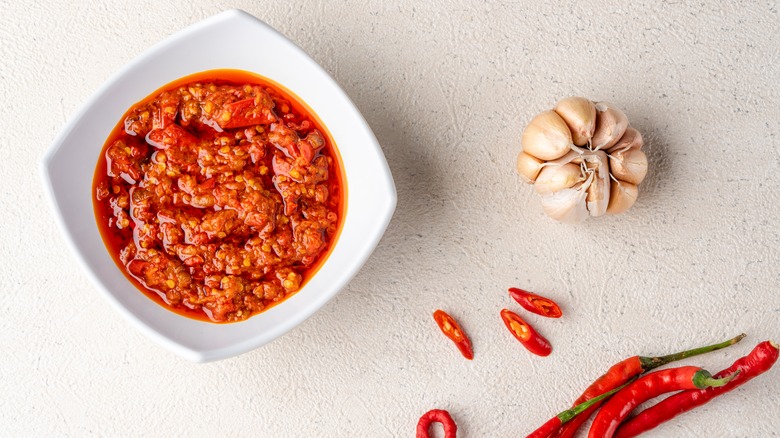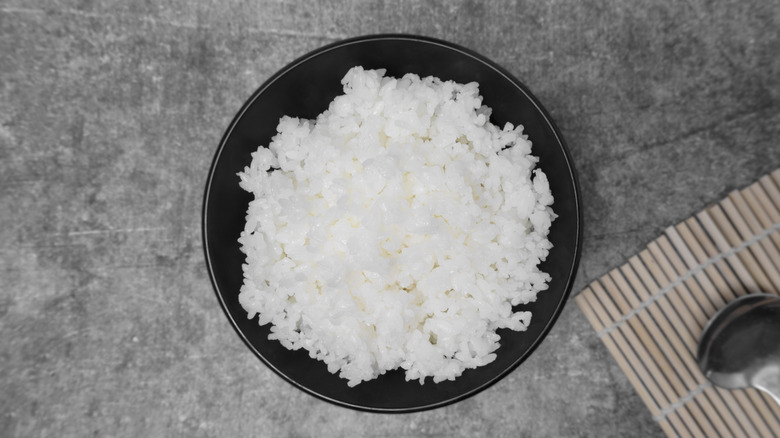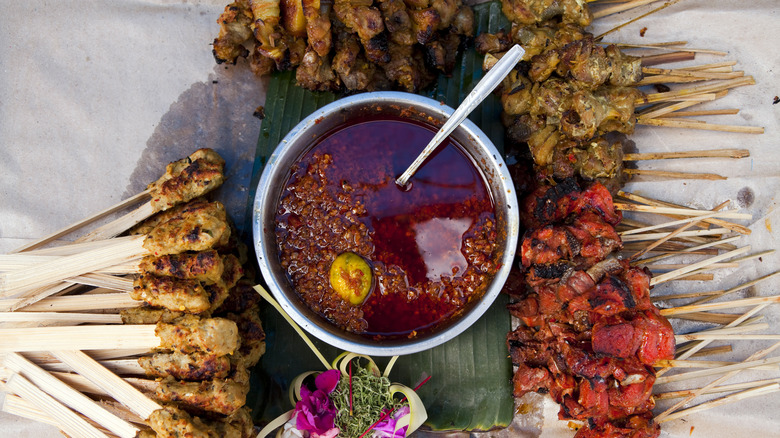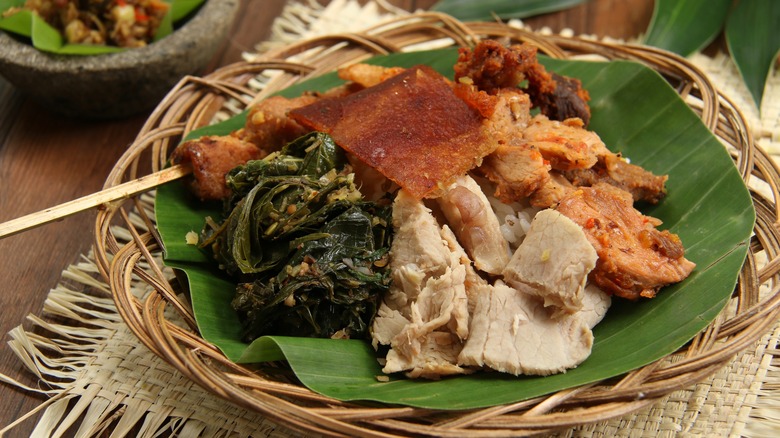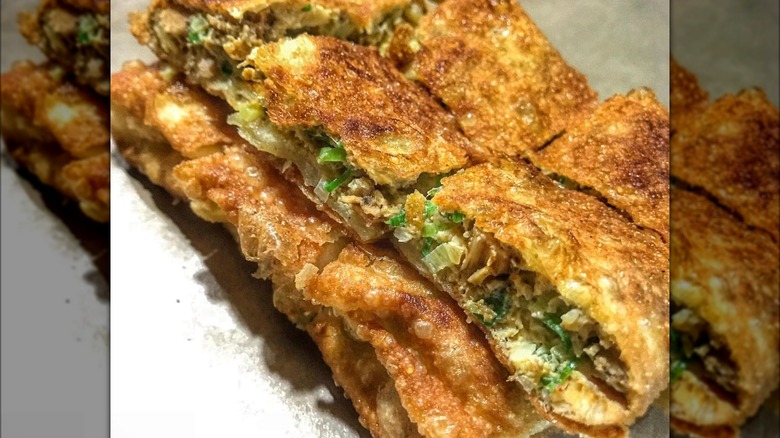14 Essential Words And Phrases To Know At An Indonesian Restaurant
Indonesian food embodies a dynamic array of flavors, showcasing the varied culinary heritage of the Southeast Asian nation. The archipelago of more than 17,000 islands offers a plethora of fresh produce, fiery spices, and fragrant herbs. With dishes that vary significantly from one region to another, Indonesia's gastronomy also offers a mix of indigenous traditions and foreign influences, including Indian, Chinese, Middle Eastern, and European, due to centuries of trade and colonization.
Navigating the menu at an Indonesian restaurant can be an exciting journey into the country's rich culinary landscape. Luckily, unlike some other Southeast Asian languages, Indonesian is pretty easy to pronounce. The language uses the Latin alphabet, much like English, and has a relatively uncomplicated phonetic system. Additionally, Indonesian isn't tonal, a feature present in many other Asian languages, which simplifies pronunciation for newcomers. Nevertheless, knowing a few basic Indonesian terms can greatly enhance your dining experience. Here are some essential Indonesian terms to help navigate your next culinary adventure.
Sambal
A staple of Indonesian cuisine, sambal is ubiquitous in Indonesian restaurants. For those uninitiated, sambal is a spicy sauce made from crushed or chopped chili peppers and an array of other ingredients such as garlic, shallots, galangal, and lemongrass. Different sambal varieties feature different compositions and ratios of ingredients, often mirroring the richness of Indonesian spices. Sambal's popularity lies in its ability to cater to a broad spectrum of tastes, offering everything from fiery heat to subtle, complex flavors. While sambal is traditionally handmade, the sauce can also be found on supermarket shelves in a commercially produced form.
Indonesia is a melting pot of flavors, and nowhere is this more evident than in its wide range of sambals. While we can't be sure exactly how many versions of the condiment exist, there are a few that stand out for their popularity. Sambal terasi, for example, is distinguished by its pungent aroma and rich flavor derived from shrimp paste. Sambal oelek stands out for its simplicity, consisting of crushed chilies, vinegar, and salt. Meanwhile, sambal cabe ijo, popular in Padang cuisine from the island of Sumatra, is made from green chilies and features a distinctive refreshing flavor that's only mildly spicy.
Nasi putih
The Indonesian word "nasi" translates to "rice" in English, and "putih" signifies "white," thus forming "nasi putih." This basic yet essential dish is a foundational element of Indonesian culinary tradition, with its neutral taste making it an ideal pairing for both savory and sweet dishes. Indeed, at an Indonesian restaurant, it's uncommon to encounter a meal that doesn't include grain as an accompanying side. Unlike in Western cuisine, where rice is usually only used in savory dishes, Indonesian cuisine also incorporates the carb-laden staple into its desserts.
Aside from nasi putih, another popular rice type in Indonesia is nasi kuning or yellow rice, also sometimes called nasi kunyit. While this rice derives its distinctive yellow color from turmeric, its flavor also comes from ingredients like lemongrass and coconut milk. Nasi kuning is often served at ceremonies and celebrations as a tumpeng, a yellow cone that comes encircled by a variety of dishes.
Nasi goreng
It's a rare sight to find an Indonesian restaurant that doesn't have nasi goreng or fried rice on its menu. Celebrated as the national dish of Indonesia, nasi goreng is as simple as it's delicious. Found in most regions of the archipelago, nasi goreng is essentially rice sautéed with a blend of spices such as chili and shallots. Several condiments are also thrown into the mix, including soy sauce, which infuses the dish with an umami flavor, and kecap manis for a touch of sweetness. Kecap manis is also what gives nasi goreng its distinctive brown hue as the sauce caramelizes during cooking. Nasi goreng is typically topped with a fried egg and deep-fried shallots and served alongside prawn crackers.
It's believed that Chinese immigrants played a significant role in the introduction of fried rice to Indonesia, which was then customized with local ingredients and spices, differentiating it from its Chinese counterpart. Nasi Goreng underwent further alterations during colonial times when the Dutch started adding meat to the dish. The introduction of rempah paste in Indonesia by the Malay community has also influenced the preparation of nasi goreng, infusing it with an aromatic mixture of spices such as ginger, turmeric, and lemongrass.
Mie goreng
In Indonesian, "mie" means noodles, and "goreng" translates to fried, which makes this dish pretty self-explanatory. However, it's worth noting that the spelling may vary on menus, also appearing as "mee goreng" or "mi goreng." Just as popular on street corners in its home country as it's in Indonesian restaurants, the stir-fried dish is a hit with those partial to the savory sweet flavor of kecap manis. While mie goreng is normally made with chewy wheat noodles, the dish is sometimes also prepared with egg noodles and even store-bought instant noodles.
When it comes to the recipe, the sauce for mie goreng is typically made with a blend of kecap manis, oyster sauce, dark soy, and sesame. Meanwhile, the noodles are stir-fried with a variety of ingredients such as chicken, prawns, green onion, egg, garlic, beansprouts, and cabbage. While each ingredient adds depth to the flavor profile of the dish, mie goreng is versatile enough to allow for the inclusion of other vegetables or meats based on personal preference. As such, it's not surprising that versions of the dish also exist in nearby Malaysia, Singapore, and Brunei Darussalam.
Sop buntut
If you ever come across sop buntut at an Indonesian restaurant, consider yourself lucky. Translating to oxtail soup in English, sop buntut is beloved both for its robust ingredients and rich flavors. Interestingly, the Dutch likely introduced a version of this soup to Indonesia during the colonial era, having themselves adapted it from an oxtail soup brought to London by Flemish Huguenot immigrants in the 17th century.
The star of the culinary show here is undoubtedly the oxtail, slow-cooked to sheer perfection until it's fall-off-the-bone tender. While traditionally boiled, today the oxtail is also commonly fried or barbecued, adding a new dimension to the protein's texture. However, that's merely the beginning. What elevates this dish is the aromatic broth that accompanies it. The savory concoction typically blends Indonesian spices such as cinnamon, clove and nutmeg powder. It's also loaded with hearty veggies like carrots and potatoes, and sprinkled with fried shallots.
Bubur ayam
Popular as a breakfast dish, bubur ayam is a comforting chicken rice porridge that may initially seem like an odd choice for a tropical climate. However, the dish is embraced in Indonesia precisely because of its warming qualities, and the combination of chicken and porridge could also be an ideal choice for cold winter mornings in the U.S. The rich broth and soft texture of the porridge are gentle on the stomach, while the shredded chicken adds a hearty protein to the dish.
Beyond its main components, bubur ayam can be customized with a variety of toppings, each bringing its own unique flavor and texture to the dish. The addition of fried bean curd and fried shallots introduces a subtle crunch, which contrasts with the soft, warm porridge. Meanwhile, peanuts can provide a wonderful nuttiness and an additional layer of texture that complements the shredded chicken. Other ingredients that frequently make an appearance in bubur ayam include celery, scallions, hard-boiled eggs, and pickled cabbage. Those who enjoy a little fire in their fare can also add sambal or Indonesian spicy chili sauce.
Tempe
Most Indonesian restaurants incorporate tempe into their culinary repertoire in one way or another. Sometimes also spelled tempeh, tempe is a fundamental part of the Indonesian diet that's normally served either as a savory side dish or a protein-packed addition to salads and main courses. Traditionally made from fermented soybeans, the fried cakes boast a nutty flavor and a firm, chewy texture.
Rich in protein, vitamins, and dietary fiber, tempe also comes with plenty of nutritional benefits — that is, if you can overlook the fact that the soy pallets are usually deep-fried in oil. While tempe is normally made from soybeans, the savory treat is also sometimes produced from grains, beans, nuts, and legumes. Tempe is a quintessentially Indonesian creation. The soy cakes have been a cornerstone of the culinary landscape of Central Java since the 18th century, eventually gaining popularity throughout the archipelago. The earliest recorded tempe recipe, sambal tumpang, is a rich curry made with tempe, coconut milk, assorted vegetables, and a variety of spices.
Krupuk
A mainstay at most Indonesian dining establishments, krupuk, also sometimes called kerupuk, is a popular type of crispy cracker, often enjoyed either as a prelude to a meal or savored as a standalone snack. Krupuk's versatility extends to its use as an appetizing addition to various traditional dishes such as nasi goreng (fried rice) and gado-gado (vegetable salad with peanut sauce), where it's commonly crumbled over the dish to enhance its flavor profile.
Krupuk crackers come in a variety of different types, each offering a unique texture and flavor. Krupuk udang, or shrimp crackers, are made from ground prawns and tapioca, and puff up when deep-fried. Made from wheat and tapioca flours, krupuk blek offers a rosette-shaped, airy bite, while krupuk bawang is distinguishable by its colorful edges and garlic-shallot flavor. Meanwhile, krupuk kulit is made from the dried skin of animals such as cattle, pigs, chickens, buffalos, and even frogs, making a perfect crunchy snack for die-hard carnivores.
Rendang
Rendang might just be one of Indonesia's most debated culinary creations. For years, the dish has been at the heart of a heated ownership dispute between Indonesia and Malaysia, so you know you're in for a treat. Indeed, both Southeast Asian countries have a long history of trading culinary influences, making the exact origins of many dishes, including rendang, tricky to pinpoint. Nevertheless, it's believed that rendang most likely originated with the Minangkabau people of West Sumatra in Indonesia sometime in the 16th century.
So what is this famed rendang? Traditionally made from buffalo meat, today rendang is frequently made with beef, however it can also be composed of chicken, fish, shrimp, squid, and egg. The flavorful dish involves slow cooking meat in coconut milk and a blend of spices, including galangal, lemongrass, garlic, turmeric, and chilies. The slow cooking technique is not just about infusing the meat with these complex flavors, but also about tenderizing it over several hours.
Sate
Also sometimes spelled satay, sate is beloved not just in Indonesia but also across Southeast Asia. The dish consists of skewers of marinated beef, chicken, pork, goat, or mutton. Before cooking, these meats are immersed in aromatic spices such as lemongrass, garlic, ginger, turmeric, and soy sauce to imbue them with flavor. Once marinated, the skewers are grilled over charcoal, resulting in a distinct smoky flavor.
One of the most popular types of sate is sate ayam, which consists of chicken skewers that have been marinated in sweet soy sauce. The dish is typically served with a peanut sauce, alongside sliced shallots and diced chilies for an extra kick. Another popular sate variant, sate kambing is made with lamb that's been soaked in ground pineapple. Originating from Bali, sate lilit offers a unique blend of minced meat or fish, combined with shredded coconut, shallots, coconut milk, and a hint of lime juice, and wrapped around lemongrass skewers.
Gado-gado
Widely regarded as a quintessential Indonesian dish, gado-gado stands out as one of the few vegetarian-friendly options commonly found on the menus of Indonesian restaurants worldwide. Served as a light meal or a hearty dinner, gado-gado blends a variety of flavors and textures. The fundamental ingredient that fuses the different components of the dish is peanut sauce. Some of the ingredients that can go into the sauce include crushed roasted peanuts, garlic, chili peppers, fermented shrimp paste, tamarind, dark soy sauce, and brown sugar.
Beyond its signature peanut sauce, the composition of gado-gado varies depending on the establishment. This adaptability may be rooted in gado-gado's origins since the dish is believed to have originated with street vendors who used leftover ingredients to create the nourishing salad. Nevertheless, the standard version of the dish features blanched or steamed vegetables such as spinach and green beans, hard-boiled eggs, lontong rice cakes, fried tofu, and tempeh.
Babi guling
Due to the predominant Muslim population, babi guling, or spit-roasted pig, is not commonly found throughout Indonesia. One place where the dish is ubiquitous, however, is the Hindu island of Bali. In fact, the dish is a bit of a speciality on the holiday island. If you happen to come upon a Balinese restaurant, or are lucky enough to be visiting the Indonesian island, you're in for a culinary treat not to be missed. Even the late chef Anthony Bourdain once raved about the dish, calling it "the best pig I have ever had" (via Nikkei Asia).
There's a lot that goes into the preparation of babi guling. Traditionally, a whole pig is marinated with a blend of herbs, spices, and coconut milk, then slow-roasted over a fire, which gives the dish its wonderful taste and aroma. However, there's much more to babi guling than tender pieces of pork meat. The dish usually also includes two or three pieces of crispy skin, a mix of veggies, and, of course, the obligatory serving of white rice. There's also basa gede, a spice mix that includes a blend of garlic, ginger, shallots, galangal, turmeric, chili peppers, coriander, and shrimp paste.
Martabak
Martabak can be whatever you want it to be, as long as you're familiar with the right lingo. The fluffy pancake-like dish can be eaten as a savory snack or a sweet treat, depending on your choice of fillings. Martabak telor is filled with a mix of eggs, minced meat, shallots, and coriander. Meanwhile, martabak manis is loaded with chocolate, shredded cheese, crushed peanuts, and condensed milk.
Interestingly, while they share a similar name, martabak manis and martabak telor are quite different when it comes to their form. The savory martabak telor is made from thin wheat dough, which is stuffed with filling, folded, and cooked until the outer layer is crispy. The final result is a little similar to Indian roti canai, Mexican quesadilla, or Turkish gözleme. The dish is typically topped with fresh chilies, red onion, coriander, and pickled cucumbers.
Martabak manis, often referred to as "Indonesian thick pancakes," presents a stark contrast to its savory counterpart, martabak telor, in both taste and composition. Made from a rich, eggy batter that puffs up during cooking, the sweet variant of martabak is known for its unique texture — soft and spongy on the inside and crispy on the outside.
Es Cendol
Those with a sweet tooth need to acquaint themselves with the Indonesian term "es cendol." A feast for both the eyes and the taste buds, es cendol is a dessert that consists of green jelly-like noodles made from rice flour. The sweet dessert is served in a refreshing concoction of coconut milk, palm sugar syrup, and shaved ice. Es Cendol is often elevated with additional toppings such as diced fruit, glutinous rice, and corn.
The origins of es cendol have sparked considerable debate between Singapore and Malaysia, which are both claiming the dessert as their own. However, evidence suggests that the dish might actually hail from Indonesia. A precursor to es cendol could date back to 12th century Java, known then as a beverage featuring the characteristic green jelly worms named Dawet. Furthermore, it's believed that the name "cendol" derives from the Indonesian term "jendol," meaning "swollen," alluding to the green jellies, which expand in contact with liquid.

